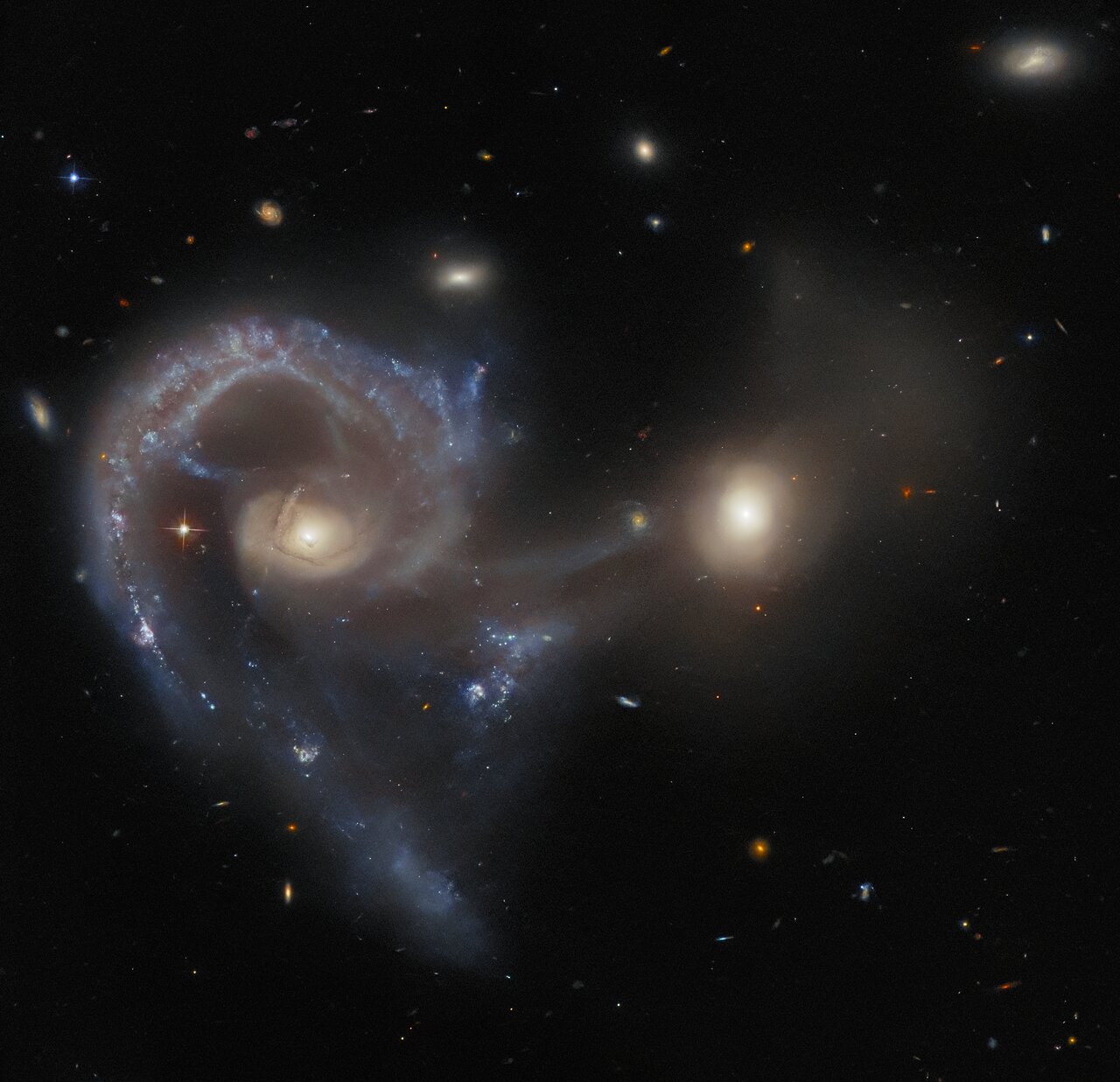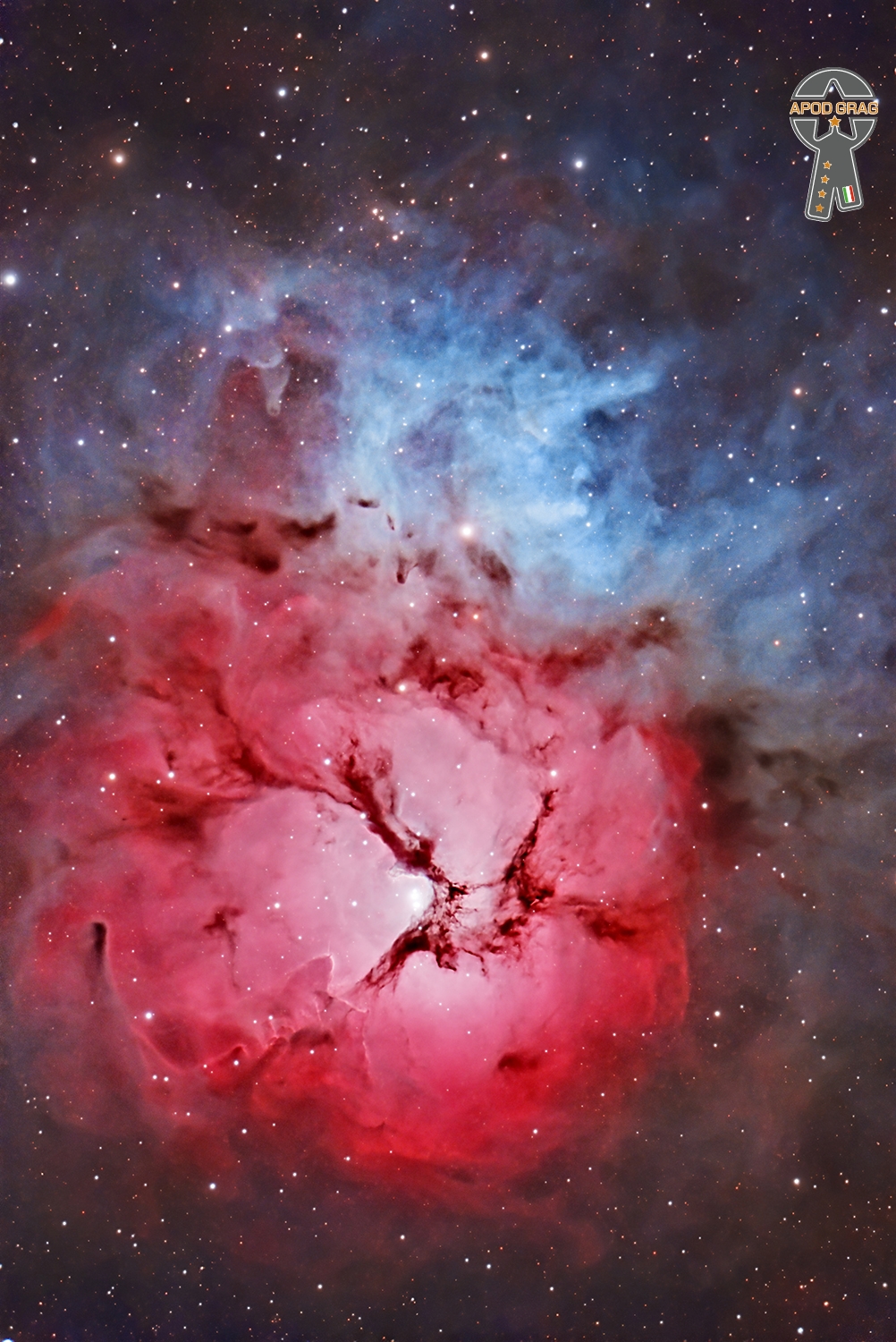Blog



This Hubble Picture of the Week — taken using NASA/ESA Hubble Space Telescope’s Advanced Camera for Surveys (ACS) — shows Arp 107, a celestial object that comprises a pair of galaxies in the midst of a collision. The larger galaxy (in the left of this image) is an extremely energetic galaxy type known as a Seyfert galaxy, which house active galactic nuclei at their cores. Seyfert galaxies are notable because despite the immense brightness of the active core, radiation from the entire galaxy can be observed. This is evident in this image, where the spiraling whorls of the whole galaxy are readily visible. The smaller companion is connected to the larger by a tenuous-seeming ‘bridge’, composed of dust and gas. The colliding galactic duo lie about 465 million light-years from Earth. Arp 107 is part of a catalogue of 338 galaxies known as the Atlas of Peculiar Galaxies, which was compiled in 1966 by Halton Arp. It was observed by Hubble as part of an observing programme that specifically sought to fill in an observational ‘gap’, by taking limited observations of members of the Arp catalogue. Part of the intention of the observing programme was to provide the public with images of these spectacular and not-easily-defined galaxies, and as such, it has provided a rich source for Hubble Pictures of the Week. In fact, several recent releases, including this one and this one, have made use of observations from the same observing programme. [Image Description: A pair of merging galaxies. The galaxy on the left has a large, single spiral arm curving out from the core and around to below it, with very visible glowing dust and gas. The right galaxy has a bright core but only a bit of very faint material. A broad curtain of gas connects the two galaxies’ cores and hangs beneath them. A few small stars and galaxies are scattered around the black background.]

Philip Gary “Flip” Sloan (né Schlein; September 18, 1945 – November 15, 2015), known professionally as P. F. Sloan, was an American singer and songwriter. During the mid-1960s, he wrote, performed, and produced many Billboard Top 20 hits for artists such as Barry McGuire, the Searchers, Jan and Dean, Herman’s Hermits, Johnny Rivers, the Grass Roots, the Turtles, and the Mamas and the Papas.
Sloan’s signature song is “Eve of Destruction,” a 1965 U.S. number one for McGuire. Many of his songs were written in collaboration with Steve Barri. Their partnership yielded two US Top Ten hits—Herman’s Hermits’ “A Must to Avoid” (1965) and Johnny Rivers’ “Secret Agent Man” (1966)—and the Turtles‘ “You Baby” (1966).
Sloan was born in New York City, United States, to an American father and a Romanian-born mother. His family moved to West Hollywood, California in 1957, where his father, a pharmacist, changed the family name from “Schlein” to “Sloan” after repeatedly being denied a liquor license for his store.
more...Emily Remler (September 18, 1957 – May 4, 1990) was an American jazz guitarist, active from the late 1970s until her death in 1990.
Born in Englewood Cliffs, New Jersey, Remler began guitar at age ten. She listened to pop and rockguitarists like Jimi Hendrix and Johnny Winter. At the Berklee College of Music in the 1970s, she listened to jazz guitarists Charlie Christian, Wes Montgomery, Herb Ellis, Pat Martino, and Joe Pass.
Remler settled in New Orleans, where she played in blues and jazz clubs, working with bands such as Four Play and Little Queenie and the Percolators before beginning her recording career in 1981. She was praised by jazz guitarist Herb Ellis, who referred to her as “the new superstar of guitar” and introduced her at the Concord Jazz Festival in 1978. Remler bore the scars of her longstanding opioid use disorder,which is believed to have contributed to her death. In May, 1990, she died of heart failure at the age of 32 at the Connells Point home of musician Ed Gaston, while on tour in Australia.
more...Steve Marcus (September 18, 1939 – September 25, 2005) was an American jazz saxophonist.
Marcus was born in The Bronx, New York, United States. He studied at the Berklee College of Music in Boston, Massachusetts, between 1959 and 1961. He gained experience playing in the bands of Stan Kenton, Herbie Mann and Larry Coryell from 1963 to 1973.[1] His first album as a leader included an arrangement of the Beatles‘ song, “Tomorrow Never Knows“. He worked with jazz drummer Buddy Rich for the last twelve years of Rich’s life. After Rich died, Marcus led the band and renamed it Buddy’s Buddies.
His song “Half a Heart” (1968) has a riff very similar to the famous saxophone riff of “Baker Street” by Gerry Rafferty (recorded in 1977, released in 1978).
Marcus died in September 2005 in New Hope, Pennsylvania.
more...
Earl Charles Barrington May (September 17, 1927 – January 4, 2008) was an American jazz bassist. He was “one of the most prodigious and prolific bassists of the postwar era”.
May was born in New York City on September 17, 1927. As a child, he played the drums, and changed to the acoustic bass at the age of 14.[1] He “played left-handed on an instrument strung for a right-handed player”.
Until 1951, May had a job in insurance while playing in clubs at night. During this period, he played with Miles Davis, Lester Young, Gene Ammons, Sonny Stitt, and Mercer Ellington. He was also taught by Charles Mingus in the early 1950s. Through most of the 1950s he played in a trio with Billy Taylor, and also worked in the late 1950s with John Coltrane and Chet Baker.
more...Lalgudi Gopala Jayaraman (17 September 1930 – 22 April 2013) was an Indian Carnatic violinist, vocalist and composer. He is commonly grouped with M.S. Gopalakrishnan and T.N.Krishnan as part of the violin-trinity of Carnatic Music. He was awarded Padma Bhushan by the Government of India in 2001.
His disciples included his two children Lalgudi G. J. R. Krishnan, Lalgudi Vijayalakshmi, his sister Lalgudi Srimathi Brahmanandam, former composer-conductor of All India Radio’s Vadya Vrinda National Orchestra P. Purnachander Rao, renowned musician S P Ramh (grandson of Shri. G.N. Dandapani Iyer), renowned Harikatha exponent Vishaka Hari, leading carnatic vocalist Saketharaman, Vittal Ramamurthy, Dr. N. Shashidhar, Film Music Composer Girishh G, Padma Shankar, Kanchan Chandran, Raghuram Hosahalli, renowned violinist from London – Shri A.G.A.Gnanasundaram, Srinivasamurthy, Pakkala Ramdas, Sankari Krishnan, Yamini Ramesh, Mumbai Shilpa, Shreya Devnath, Krithika Natarajan, Salem Sisters, the leading Vainika Srikanth Chary and the Academy Award-nominated Bombay Jayashri Ramnath.
more...Eugene McDuff (September 17, 1926 – January 23, 2001), known professionally as “Brother” Jack McDuffor “Captain” Jack McDuff, was an American jazz organist and organ trio bandleader who was most prominent during the hard bop and soul jazz era of the 1960s, often performing with an organ trio. He is also credited with giving guitarist George Benson his first break.
Born Eugene McDuffy in Champaign, Illinois, McDuff began playing bass, appearing in Joe Farrell’s group.Encouraged by Willis Jackson in whose band he also played bass in the late 1950s, McDuff moved to the organ and began to attract the attention of Prestige while still with Jackson’s group. McDuff soon became a bandleader, leading groups featuring a young George Benson on guitar, Red Holloway on tenor saxophone and Joe Dukes on drums.
McDuff recorded many classic albums on Prestige, including his debut solo Brother Jack in 1960; The Honeydripper (1961), with tenor saxophonist Jimmy Forrest and guitarist Grant Green; Brother Jack Meets The Boss (1962), featuring Gene Ammons; Screamin’ (1962), with alto saxophonist Leo Wright and guitarist Kenny Burrell; and Brother Jack McDuff Live! (1963), featuring Holloway and Benson, which includes his biggest hit, “Rock Candy”. Despite health problems, McDuff continued working and recording throughout the 1980s and 1990s, and he toured Japan with Atsuko Hashimoto in 2000. “Capt’n” Jack McDuff, as he later became known, died of heart failure at the age of 74 in Minneapolis, Minnesota. His first wife, the former Dink Dixon, died in the early 1980s. McDuff leaves his second wife Kathy and her two children.
more...
Hiram “Hank” Williams (September 17, 1923 – January 1, 1953 Butler County, AL) was an American singer-songwriter. He is regarded as one of the most significant and influential American singers and songwriters of the 20th century. Williams recorded 55 singles that reached the top 10 of the Billboard Country & Western Best Sellers chart, five of which were released posthumously, including 12 that reached No. 1, three after his death.
Born and raised in Alabama, Williams learned guitar from African-American blues musician Rufus Payne. Both Payne and Roy Acuff significantly influenced his musical style. After winning an amateur talent contest, Williams began his professional career in Montgomery in the late 1930s playing on local radio stations and at area venues such as school houses, movie theaters, and bars. He formed the Drifting Cowboys backup band, which was managed by his mother, and dropped out of school to devote his time to his career. When several of his band members were drafted during World War II, he had trouble with their replacements, and he was fired and rehired several times by radio station WSFA because of his unreliability caused by his alcoholism.
In 1944 Williams married Audrey Sheppard, who competed with his mother to control his career. After recording “Never Again” and “Honky Tonkin’” with Sterling Records, he signed a contract with MGM Records. He released the hit single “Move It On Over” in 1947 and joined the Louisiana Hayride radio program. The next year he released a cover of “Lovesick Blues,” which quickly reached number one on Billboard‘s Top Country & Western singles chart and propelled him to stardom on the Grand Ole Opry. Although unable to read or notate music to any significant degree, he wrote such iconic hits as “Your Cheatin’ Heart“, “Hey, Good Lookin’“, and “I’m So Lonesome I Could Cry“. In 1952, Sheppard divorced him and he married Billie Jean Horton. He was dismissed by the Grand Ole Opry because of his unreliability and alcoholism.
Years of back pain, alcoholism, and prescription drug abuse severely compromised Williams’ health, and at the age of 29, Williams suffered from heart failure and died suddenly in the back seat of a car near Oak Hill, West Virginia en route to a concert in Canton, Ohio on New Year’s Day 1953. Despite his relatively brief career, he is one of the most celebrated and influential musicians of the 20th century, especially in country music. Many artists have covered his songs and he has influenced Chuck Berry, Elvis Presley, Johnny Cash, Bob Dylan, and the Rolling Stones, among others. He was inducted into the Country Music Hall of Fame in 1961, the Songwriters Hall of Fame in 1970, the Rock and Roll Hall of Fame in 1987, the Native American Music Awards Hall of Fame in 1999, and gained a star on the Hollywood Walk of Fame. In 2010 he was awarded a posthumous Pulitzer Prize Special Citation for his “craftsmanship as a songwriter who expressed universal feelings with poignant simplicity and played a pivotal role in transforming country music into a major musical and cultural force in American life.” Around midnight on January 1, 1953, the two crossed the Tennessee state line and arrived in Bristol, Virginia. Carr stopped at a small all-night restaurant and asked for a relief driver from a local taxi company, as he felt exhausted after driving for 20 hours. Driver Don Surface left the restaurant with Carr and Williams. They drove on until they stopped for fuel and coffee at a gas station in Oak Hill, West Virginia, where they realized that Williams had been dead for so long that rigor mortis had already set in.
more...
The Trifid Nebula (catalogued as Messier 20 or M20 and as NGC 6514) is an H II region in the north-west of Sagittarius in a star-forming region in the Milky Way’s Scutum-Centaurus Arm. It was discovered by Charles Messier on June 5, 1764. Its name means ‘three-lobe’. The object is an unusual combination of an open cluster of stars, an emission nebula (the relatively dense, reddish-pink portion), a reflection nebula (the mainly NNE blue portion), and a dark nebula (the apparent ‘gaps’ in the former that cause the trifurcated appearance, also designated Barnard 85). Viewed through a small telescope, the Trifid Nebula is a bright and peculiar object, and is thus a perennial favorite of amateur astronomers.

Leopoldo F. Fleming (born September 16, 1939 in Puerta de Tierra, Puerto Rico) is an American jazz musician (percussion, composition, arrangement).
Live and act
Fleming, who came from a family of musicians, grew up first in Puerto Rico, from 1947 on Saint Thomas and from 1951 in New York City. He played congas as a child; his father taught him Latin rhythms. At the age of 15 he accompanied dancers as a percussionist. Shortly afterwards he played in a Latin big band led by Red Dixon and Jesse DeVore.
In 1965, Hugh Masekela brought him into Miriam Makeba’s accompanying trio, in which he worked until the mid-1970s. He toured internationally with Makeba and was also involved in their albums such as Click Song and Pata Pata. Since 1971 he was also a member of Nina Simone’s band, with whom he worked until the 1980s. He also worked as a theater musician. He was musical director of LeRoi Jones’ Slaveship in Brooklyn; In this production by Gilbert Moses he appeared with Archie Shepp. He also composed for the American children’s television series Vegetable Soup.
more...Earl Klugh born September 16, 1953) is an American acoustic guitarist and composer. He has won one Grammy award and thirteen nominations. Klugh was awarded the “1977 Best Recording Award For Performance and Sound” for his album “Finger Painting” by “Swing Journal” a Japanese jazz magazine.
At the age of six, Klugh commenced training on the piano until he switched to the guitar at the age of ten. At the age of thirteen, Klugh was captivated by the guitar playing of Chet Atkins when Atkins made an appearance on the Perry Como Show. Klugh was a performing guest on several of Atkins’ albums. Atkins, reciprocating as well, joined Earl on his Magic In Your Eyes album. Klugh also appeared with Atkins on several television programs, including Hee Haw and a 1994 TV special titled “Read my Licks”. Klugh was also influenced by Bob James, Ray Parker Jr, Wes Montgomery and Laurindo Almeida. His sound is a blend of these jazz, pop and rhythm and blues influences, forming a potpourri of sweet contemporary music original to only him.
more...Charlie Lee Byrd (September 16, 1925 – December 2, 1999) was an American jazz guitarist. Byrd was best known for his association with Brazilian music, especially bossa nova. In 1962, he collaborated with Stan Getz on the album Jazz Samba, a recording which brought bossa nova into the mainstream of North American music.
Byrd played fingerstyle on a classical guitar.
Charlie Byrd was born in 1925 in Suffolk, Virginia, and grew up in the borough of Chuckatuck. His father, a mandolinist and guitarist, taught him how to play the acoustic steel guitar at age 10. Byrd had three brothers, Oscar, Jack, and Gene “Joe” Byrd, who was a bass player. In 1942, Byrd entered the Virginia Polytechnic Institute and played in the school orchestra. In 1943, he was drafted into the United States Army, saw combat in World War II, and was stationed in Paris in 1945. There he played in an Army Special Services band and toured occupied Europe in the all-soldier production G.I. Carmen.
After the war, Byrd returned to the United States and studied composition and jazz theory at the Harnett National Music School in Manhattan, New York City. During this time, he began playing a classical guitar. After moving to Washington, D.C., in 1950, he studied classical guitar with Sophocles Papas for several years. In 1954, he became a pupil of the Spanish classical guitarist Andrés Segovia and spent time studying with him in Italy.
Byrd’s earliest and greatest influence was the gypsy guitarist Django Reinhardt, whom he saw perform in Paris.
more...Riley B. King (September 16, 1925 – May 14, 2015), known professionally as B. B. King, was an American blues guitarist, singer, songwriter, and record producer. He introduced a sophisticated style of soloing based on fluid string bending, shimmering vibrato, and staccato picking that influenced many later blues electric guitar players. AllMusic recognized King as “the single most important electric guitarist of the last half of the 20th century”.
King was inducted into the Rock and Roll Hall of Fame in 1987 and is one of the most influential blues musicians of all time, earning the nickname “The King of the Blues”, and is considered one of the “Three Kings of the Blues Guitar” (along with Albert King and Freddie King, none of whom are related). King performed tirelessly throughout his musical career, appearing on average at more than 200 concerts per year into his 70s. In 1956 alone, he appeared at 342 shows.
King was born on a cotton plantation of Berclair, near the city of Itta Bena, Mississippi, and later worked at a cotton gin in Indianola, Mississippi. He was attracted to music and taught himself to play guitar and began his career in juke joints and local radio. He later lived in Memphis and Chicago; then, as his fame grew, he toured the world extensively. King died at 89 in Las Vegas in 2015.
Riley B. King was born on September 16, 1925, on a cotton plantation of Berclair named Bear Creek in Leflore County, near the city of Itta Bena, Mississippi, the son of sharecroppers Albert and Nora Ella King. When King was four years old, his mother left his father for another man, so he was raised by his maternal grandmother, Elnora Farr, in Kilmichael, Mississippi, then in Lexington. As a teen, he moved to Indianola, which he referred to as his hometown and he later worked at a cotton gin. King served in the U.S. Army during World War II but was released after being ruled as “essential to the war economy” based on his experience as a tractor driver.
more...More Posts
- Daily Roots with Black Omolo
- The Cosmos with NGC 3597
- Louis Myers Day
- Frank Socolow Day
- World Music with Lazaro Ros
- Daily Roots with Coco Tea
- The Cosmos with AM 0644-741
- Jack McDuff Day
- Blind James Campbell Day
- World Music with Rosie & Allen Sula
- Daily Roots with Joe Gibbs and the Professionals
- The Cosmos with the Sun
- B. B. King Day
- Charlie Byrd Day
- Joe Venuti Day
- World Music with Mihrigul Hesen
- Daily Roots with the Twinkle Brothers
- “Second Chance” Elliot Park 9-15-18 1pm
- The Cosmos with NGC 2392
- Julian “Cannonball” Adderley Day